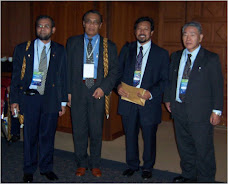
Developing A Comfortable and Energy Efficient Government's Office Building Design
A Collaborative Research between Building Technology & Innovation Section, Architectural Branch, JKR and UTM Built Environmental Research Group.
JKR has over the years become the driving forces on development and construction of government buildings such as office, schools, police stations and residential quarters for government staff. JKR has design standard office building for government since 1960’s. Currently some buildings for government office were design by appointed consultants.
The current trends on office building design worldwide has shifted on office that is not only efficient and environmental friendly but also provides high level of comfortable and user response space layout in order to suite to new office space usage. Thus the future standard for government office building design must be responsive with dynamic works environment focusing on the whole building design solution, which are comfortable, energy efficient and create productive environment.
The question is does the government office design comfortable to employee? In providing comfortable works area, are office buildings designs with Energy Efficient criterion?
Studies shows current office building in Malaysia consumes high energy with average Building Energy Index (BEI) of 200 to 300 kWh/m2/yr, whereas the BEI between 65 to 135 kWh/m2/yr is achievable if the building were design with high consideration on climatic and energy efficient consideration as demonstrated by GEO in Bangi and LEO Building in Putrajaya.
In hot and humid climates like in Malaysia, natural sunlight have draw back of increasing heat gain into the building, which in turn increases the use of air-condition load if designer does not carefully understood the impact of solar radiation. Use of daylighting is not considered as an important design criterion in most government buildings. The main reason is the misconception of differentiating sunlight and daylight characteristics.
Generally sunlight transmits solar heat gains but proper daylight do not consist of heat gain. Direct use of natural light (sunlight & daylight) contribute to direct solar heat gain and glare on the office occupants. Furthermore high cooling load and energy consumption are unresolving issues that the building owners have to bear.
Although there were effort to protect direct solar radiation by introducing shading device, there are little guideline found. Some researches previously studied the impact of solar shading, window size and room geometry on building daylight distribution and energy consumption as demonstrated by Zain-Ahmad (2002); Sharifah and Sai (2004); Ossen (2005); Loutzenhiser et al. (2007); Havid et al. (2008); Lim et al. (2009). However, environmental research demonstrates that the performances of building elements are not really applied the occupant comfortable in office building as a whole. So far, there is lack of focus of integrating the building system to fulfill building environmental performance requirements and occupant comfort.
This study investigates the effect of natural lighting on existing office building designs and the impact on occupant comfort as well as energy efficiency in office building. The research will begin with the investigation of a number of existing government offices. The study will be conducted using both social or field survey and computer simulation modeling software. The findings of the study will be in the form of reports and guideline for building designer. The proposed office building design guideline will not only comply with the MS: 1525 building performance criterion but also look for innovative solutions appropriate for Malaysia climate and office space requirement today and in future.
This RM450K research project headed by Associate Profesor Dr Mohd Zin Kandar. Other co-researcher are Prof Dr. Mohd Hamdan, A.P Dr Aminatuzuhariah, Dr Delsan Remaz and five researchers from JKR headed by Mdm Young Razidah.



















No comments:
Post a Comment